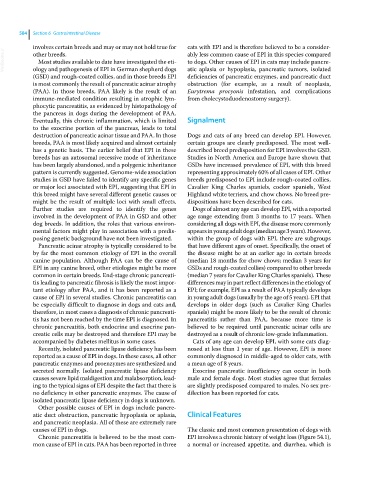Page 616 - Clinical Small Animal Internal Medicine
P. 616
584 Section 6 Gastrointestinal Disease
involves certain breeds and may or may not hold true for cats with EPI and is therefore believed to be a consider-
VetBooks.ir other breeds. ably less common cause of EPI in this species compared
Most studies available to date have investigated the eti-
to dogs. Other causes of EPI in cats may include pancre-
ology and pathogenesis of EPI in German shepherd dogs
deficiencies of pancreatic enzymes, and pancreatic duct
(GSD) and rough‐coated collies, and in those breeds EPI atic aplasia or hypoplasia, pancreatic tumors, isolated
is most commonly the result of pancreatic acinar atrophy obstruction (for example, as a result of neoplasia,
(PAA). In those breeds, PAA likely is the result of an Eurytrema procyonis infestation, and complications
immune‐mediated condition resulting in atrophic lym- from cholecystoduodenostomy surgery).
phocytic pancreatitis, as evidenced by histopathology of
the pancreas in dogs during the development of PAA.
Eventually, this chronic inflammation, which is limited Signalment
to the exocrine portion of the pancreas, leads to total
destruction of pancreatic acinar tissue and PAA. In those Dogs and cats of any breed can develop EPI. However,
breeds, PAA is most likely acquired and almost certainly certain groups are clearly predisposed. The most well‐
has a genetic basis. The earlier belief that EPI in these described breed predisposition for EPI involves the GSD.
breeds has an autosomal recessive mode of inheritance Studies in North America and Europe have shown that
has been largely abandoned, and a polygenic inheritance GSDs have increased prevalence of EPI, with this breed
pattern is currently suggested. Genome‐wide association representing approximately 60% of all cases of EPI. Other
studies in GSD have failed to identify any specific genes breeds predisposed to EPI include rough‐coated collies,
or major loci associated with EPI, suggesting that EPI in Cavalier King Charles spaniels, cocker spaniels, West
this breed might have several different genetic causes or Highland white terriers, and chow chows. No breed pre-
might be the result of multiple loci with small effects. dispositions have been described for cats.
Further studies are required to identify the genes Dogs of almost any age can develop EPI, with a reported
involved in the development of PAA in GSD and other age range extending from 3 months to 17 years. When
dog breeds. In addition, the roles that various environ- considering all dogs with EPI, the disease more commonly
mental factors might play in association with a predis- appears in young adult dogs (median age 3 years). However,
posing genetic background have not been investigated. within the group of dogs with EPI, there are subgroups
Pancreatic acinar atrophy is typically considered to be that have different ages of onset. Specifically, the onset of
by far the most common etiology of EPI in the overall the disease might be at an earlier age in certain breeds
canine population. Although PAA can be the cause of (median 18 months for chow chows; median 3 years for
EPI in any canine breed, other etiologies might be more GSDs and rough‐coated collies) compared to other breeds
common in certain breeds. End‐stage chronic pancreati- (median 7 years for Cavalier King Charles spaniels). These
tis leading to pancreatic fibrosis is likely the most impor- differences may in part reflect differences in the etiology of
tant etiology after PAA, and it has been reported as a EPI; for example, EPI as a result of PAA typically develops
cause of EPI in several studies. Chronic pancreatitis can in young adult dogs (usually by the age of 5 years). EPI that
be especially difficult to diagnose in dogs and cats and, develops in older dogs (such as Cavalier King Charles
therefore, in most cases a diagnosis of chronic pancreati- spaniels) might be more likely to be the result of chronic
tis has not been reached by the time EPI is diagnosed. In pancreatitis rather than PAA, because more time is
chronic pancreatitis, both endocrine and exocrine pan- believed to be required until pancreatic acinar cells are
creatic cells may be destroyed and therefore EPI may be destroyed as a result of chronic low-grade inflammation.
accompanied by diabetes mellitus in some cases. Cats of any age can develop EPI, with some cats diag-
Recently, isolated pancreatic lipase deficiency has been nosed at less than 1 year of age. However, EPI is more
reported as a cause of EPI in dogs. In these cases, all other commonly diagnosed in middle‐aged to older cats, with
pancreatic enzymes and proenzymes are synthesized and a mean age of 8 years.
secreted normally. Isolated pancreatic lipase deficiency Exocrine pancreatic insufficiency can occur in both
causes severe lipid maldigestion and malabsorption, lead- male and female dogs. Most studies agree that females
ing to the typical signs of EPI despite the fact that there is are slightly predisposed compared to males. No sex pre-
no deficiency in other pancreatic enzymes. The cause of dilection has been reported for cats.
isolated pancreatic lipase deficiency in dogs is unknown.
Other possible causes of EPI in dogs include pancre-
atic duct obstruction, pancreatic hypoplasia or aplasia, Clinical Features
and pancreatic neoplasia. All of these are extremely rare
causes of EPI in dogs. The classic and most common presentation of dogs with
Chronic pancreatitis is believed to be the most com- EPI involves a chronic history of weight loss (Figure 54.1),
mon cause of EPI in cats. PAA has been reported in three a normal or increased appetite, and diarrhea, which is

